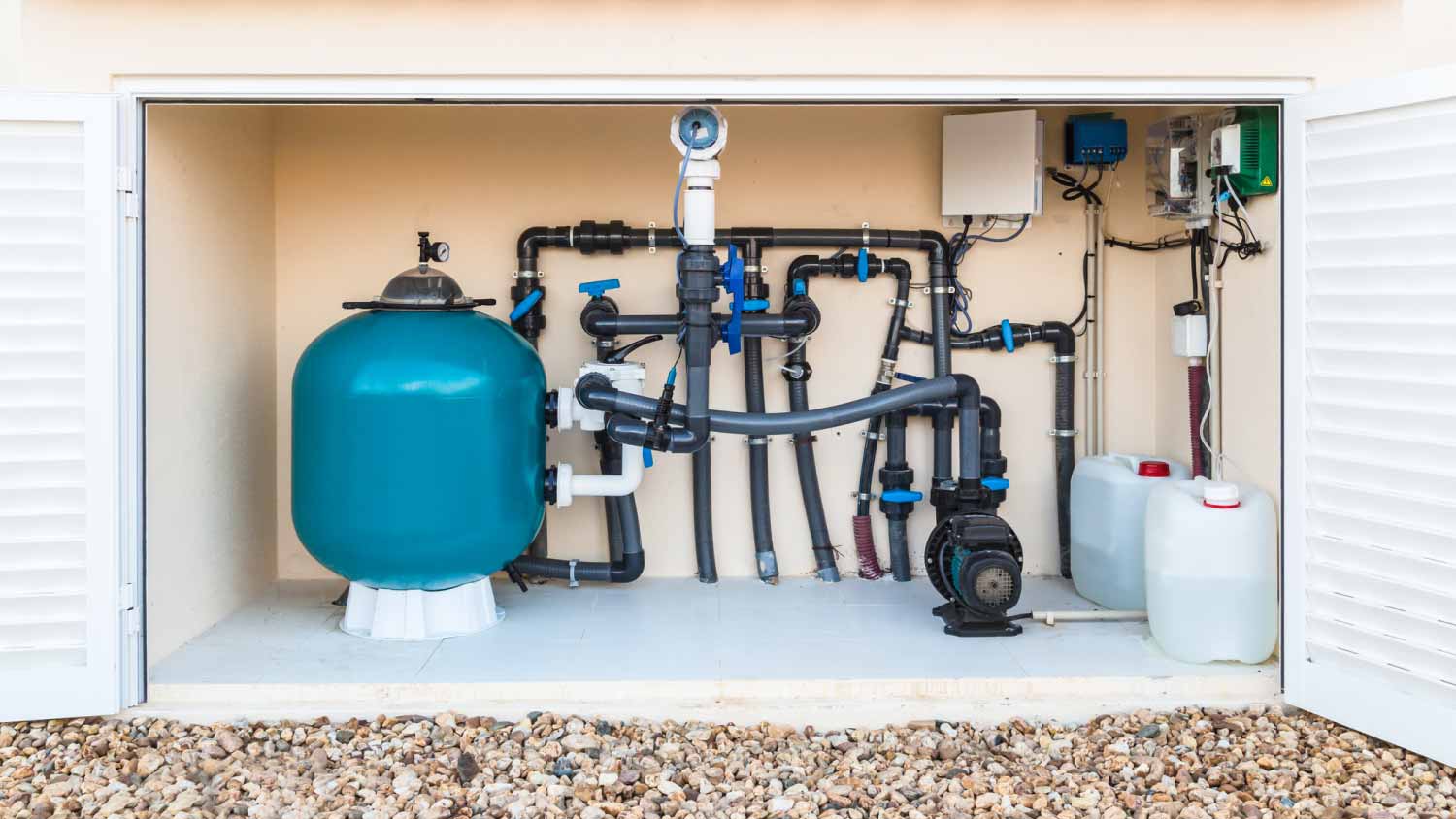
Removing a pool is a labor-intensive job, but the investment can be worth it. Use this pool removal cost guide to estimate how much you’ll pay for the service.
Keep calm and filter on


Sand pool filters are efficient, long-lasting, and use sand to filter debris from pool water.
The amount of sand your filter needs depends on the size of the filter.
Regularly backwashing your filter and replacing the sand will keep your pool water cleaner.
Sand alternatives include zeolite and glass, but make sure they’re compatible with your filter.
When it comes to keeping your pool water as clear as the summer sky, the unsung hero is a sand filter. But how much sand does a pool filter need? Too little sand will allow debris to get through and make the water cloudy, but too much sand can clog the filter and reduce efficiency. Below, we plunge into the granular details to help you keep your pool ready for a splash-tacular summer.
Sand filters are efficient and simple to run, so it’s no surprise they’re a popular pool maintenance tool. As water flows through the filter filled with graded sand, the sand particles trap dirt and debris before returning the clean water to the pool. Therefore, pool filters must have the right type and amount of sand to work correctly. The amount of sand needed for a pool filter depends on the filter size and model.
Not all sand is created equal when it comes to pool filtration, either. Pool filter sand is graded for uniform grain size between 0.45 and 0.55 millimeters. Grains that are too large won’t trap fine debris, which can let dirty or cloudy water back into your pool. On the other hand, sand that’s too fine can clog the filter, restrict water flow, and make the pump work harder.
How much sand a pool filter needs varies with the filter’s dimensions.
| Pool Filter Size (Inches) | Amount of Sand Required (Pounds) |
|---|---|
| 16 | 100 |
| 18 | 150 |
| 20 | 200 |
| 23 | 250 |
| 25 | 300 |
| 30 | 350 |
These are approximate amounts that vary based on the manufacturer and model, so read your filter’s manual for specific recommendations. If you can’t find your pool filter manual, you can estimate the required sand amount:
Look up the manual online: If you know your pool brand and model, look up the manufacturer’s website for guidance.
Measure the pool filter tank: Find the diameter of the filter tank in inches and use the general fill guidelines above.
Check for fill line markings: Look inside the filter tank for a fill line, then add sand to that line.
Use the two-thirds rule: Most sand filters should be filled two-thirds to three-quarters full—play it safe by filling two-thirds of the filter with sand.
If estimating isn’t your style and you need help determining your pool filter size or how much sand it needs, contact a local pool service for assistance.

Filters are one of the most essential parts of a pool, and you’ll most likely notice the difference if they aren’t working well. To keep your sand filter operating at peak performance, follow the manufacturer’s maintenance recommendations or ask your pool company. The following are common suggestions for sand filter maintenance.
| Type of Maintenance | Frequency | What It Does |
|---|---|---|
| Filter backwashing | Every 4–6 weeks or when pressure increases to 8–10 psi | Flushes out trapped debris |
| Sand replacement | Every 3–5 years | Maintains effective filtration |
Proper pool maintenance requires close attention to your pool’s water chemistry, filtration, and circulation. Test the water regularly, especially in the summer, and empty all the baskets. Run the filtration system four to six hours per day in the winter and six to 10 hours per day in the summer.
Most pool filters use silica sand, but you can use alternatives like zeolite and glass. Like sand, zeolite is a silicate. Silicates are naturally formed minerals (although you can buy synthetic silicates) that are microporous, meaning they trap larger molecules and let smaller molecules flow through. Zeolite has smaller openings than sand, so it traps smaller particles of debris, which reduces chloramine levels in pool water.
Glass is also an eco-friendly and efficient filtration option. You can buy recycled filter glass, and it can last up to three times longer than sand. It also filters smaller particles than sand and costs less than sand filters.
If you want to use an alternative filtration medium, talk with your pool service to make sure it’s compatible with your current pool system. They can also advise you on how it may add to the cost of maintaining your pool, how much filtration substrate to add to the filter, how often to change it, and maintenance tips.
From average costs to expert advice, get all the answers you need to get your job done.

Removing a pool is a labor-intensive job, but the investment can be worth it. Use this pool removal cost guide to estimate how much you’ll pay for the service.

Thinking about switching from chlorine to salt water in your pool? Learn how much a saltwater pool conversion costs in this informational guide.

Knowing you have a pool leak is one thing, but finding it is another. We'll cover pool leak detection costs and what to expect from the repair bill.

It’s always best to hire a pool electrician to work on your pool's electrical systems. Our guide breaks down everything you need to know about hiring this pro for your pool.

From soaks to aerobics to cold dips, having a plunge pool offers tons of benefits. Learn everything you need to know about DIY plunge pool ideas and tips.

Dreaming of getting in those daily laps without tearing up your backyard? Here’s what to know about endless pool costs so you can plan your project.